Chapter 7. Linking the Information Commons to Learning
Coalition for Networked Information
What exactly is an information commons? Just a new name that institutions give to renovated library spaces? A library reference area that has been spruced up with new furniture and equipped with a large number of computer workstations? Or something more? Are some entire libraries information commons? Is there any genuine meaning in the change in terminology from "information" commons to "learning" commons? This chapter explores the concept of the information commons, describes some of its features, and focuses on the links between information commons and learning. The information should help those involved in planning information commons make choices that ensure the space supports the academic mission of the institution.
Characterizing the Information Commons
Many institutions are renovating their libraries to become information commons or learning commons. Frequently, the information commons occupies one floor of a library facility, generally a main service floor, which often includes or replaces the library's reference area. Most information commons are currently in library spaces that have been renovated; a minority are in totally new buildings. A small number of information commons are in nonlibrary buildings.1
These renovated facilities have become enormously successful, if gate count statistics are used as a measure. At Indiana University, for example, the main library gate count almost doubled from the year prior to the opening of the information commons to the second full year of its existence.2 Although statistics such as gate counts illustrate the impact of an information commons, there is more to success than just getting students into the library's facilities. St. Thomas University's librarian explained:
I see that one rationale for the Commons is to "get the students to the library." In our case, it has been very effective in attracting students…our gate count was 110 percent higher…so, it will attract students. But that begs the question?once they are in the building, what do we do with them? How do we engage them? The rationale for the learning commons, in my view, is that, properly designed, implemented, and operated, it will enhance student learning and scholarship. That is the real challenge, and the real goal, of the learning commons.3
Pervasive Technology
Information commons have drawn students by offering environments that address their needs,4 bringing together technology, content, and services in a physical space that results in an environment different from that of a typical library. Traditional libraries offer technology, content, and services, so what is new or different about the information commons? The technology in an information commons is intentionally more pervasive than in most traditional academic libraries. If not already a feature of the library, wireless access is added when the information commons is developed. In addition, increased hardwired Internet connections let students access large files, such as multimedia, or offer an alternative to wireless when the network becomes saturated at peak use times.
Some information commons have hundreds of computers configured with a rich application suite as well as space for laptops. The software on the public computers is much more extensive than that available in typical libraries, including word-processing, presentation, and spreadsheet software, at a minimum. In addition, some workstations have statistical packages, geographic information systems (GIS), or multimedia production and editing capabilities. In contrast, workstations in many traditional library reference areas limit what users can do, namely, check the library's catalog or access licensed information products and Web resources, but do not allow for writing papers, manipulating data, or developing presentations. Some view workstations in traditional library reference areas as consuming valuable space where expert help on information resource discovery and retrieval is available and therefore limit the functions to accessing and retrieving information. In an information commons, the underlying philosophy is to provide users with a seamless work environment so that they may access, manage, and produce information all at the same workstation.
Group Spaces
Another major difference between an information commons and traditional libraries is the way in which they accommodate groups. Traditional libraries have focused on providing quiet space for individual study. Occasionally, a few group study rooms are available, but they are considered a peripheral feature of the library. In an information commons, much of the space is configured for use by small groups of students, reflecting students' desire for collaborative learning and combining social interaction with work. Information commons frequently have furniture built to accommodate several people sharing a common computer and provide large tables where several students can use their laptops while working together, comfortable seating areas with upholstered furniture to encourage informal meetings, cafés with food and drink, and group study rooms, often with a computer and screen, so students can work together efficiently on projects. (See Figure 1.)
Figure 1. Group Space in Information Commons at (a) University of Massachusetts Amherst and (b) University of Binghamton
(a)
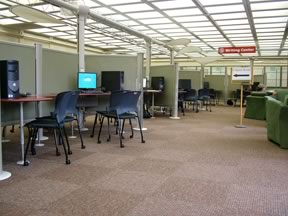
Photo courtesy of UMass/Amherst
(b)
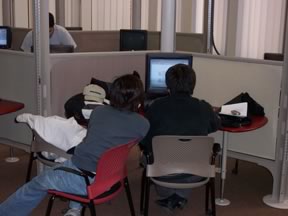
Photo courtesy of Binghamton University Libraries Information Commons
User Services, Not Just Information Services
The range of services in an information commons is broader than in a traditional reference area. Personnel assist with users' technology needs, not just their information needs. Information commons that include multimedia production capabilities also provide support for those specialties. A service desk in the information commons generally is jointly staffed by library and information technology personnel. Students do not have to know the library's or computer center's administrative structure to ask for help; they can ask questions at a central location and receive help with a wide range of problems.
Some information commons carry the notion of one-stop shopping even further, inviting other campus services into the space. For example, the writing center and faculty teaching and learning center are frequent partners in an information commons. Students writing papers or preparing other course assignments need to access and organize information (library functions), use software and equipment (IT functions), and write the paper or put together a project (writing center function). The library, the computer center, and the writing center all support students' work, sometimes from widely disparate locations on campus. Having staff from all three units available in the information commons, or having cross-trained staff who can answer basic questions in all areas, serves students well. The University of Minnesota opened its information commons following a series of focus groups with students who wanted "one place where students can research and write their papers with librarians, writing tutors, and computer assistants all there."5
Teaching and learning centers, another frequent partner in information commons, offer support to faculty who have an interest in developing new curricular materials or entirely new courses. Faculty benefit from having high-end computers and software available in the same facility as library content (which may already be in digital form or can be digitized) and pedagogical experts (instructional technologists or other professionals).
The overall goal of information commons is to improve services to the campus community by offering a seamless environment that supports the way people work.
Linking the Information Commons to Learning
Some information commons have vision or mission statements that directly address the relationship between the commons and the learning mission of the university. For example,
The University of Alberta Libraries' Knowledge Common will become a unique learning hub integrating technology, information, and expertise in order to best strengthen the teaching, research, and learning opportunities that occur within the university community. The Knowledge Common will become a focal point on campus where the elements of meeting, collaboration, and discovery come together (http://www.library.ualberta.ca/kcommon/services/indext.cfm).
Making this linkage operational can be a challenge.
Enabling Student Work
Walking into a busy information commons on a weekday evening, an observer would likely see groups of students clustered around computers, some chatting, others talking on cell phones, some with headphones listening to audio while they work on computers, and some working on their own, perhaps on a laptop, with coffee and snacks, books and notebooks spread out on a table. It would be difficult to tell, without peering over their shoulders, exactly what types of activities the students were engaged in, particularly whether they're recreational or academic. Are they playing computer games? Buying things on the Internet? Sending and receiving instant messages? Or are they involved in more scholarly pursuits, such as accessing journals licensed by the library, using art image collections, writing papers, editing videos for course projects, or accessing assignments through a course management system? The students probably are doing some of each.
Today's students mix academic and social activities. Some see their multitasking as a troublesome lack of ability to concentrate, but it is a logical strategy for students who grew up in a world with media in many formats at their fingertips 24 hours a day. Information commons, with their large numbers of computers, range of software, and spaces configured for groups, provide an ideal environment for students to collaborate with others and multitask. Developing spaces where students can collaborate outside class provides support for an increased emphasis on teamwork, both in and outside higher education.6
One satisfied student at the University of Tennessee, where the first phase of its information commons opened in fall 2005, stated,
Every time I have been in the library after hours, the Commons has been packed full of students. Some students were finishing assignments, some doing group projects, and some just relaxing with friends. The group study areas are of the perfect number and size, and the computers have all the programs I could need on them.7
Students spend much of their time learning outside classrooms by reading, exploring, creating, and communicating. The information commons creates an environment that nurtures these activities by providing content in a variety of formats, technologies that might not be affordable to individual students, and spaces built to encourage collaboration and interaction. Outside the classroom, students extend their understanding of the basic course concepts and make the learning their own by investigating a topic and producing a product that integrates it with the content of the course.8 Doing this type of work engages students in their coursework and the discipline.9
A key purpose of an information commons is to leverage the intersection of content, technology, and services in a physical facility to support student learning. For example, a student in a 20th-century film course might develop a paper, primarily text, that embeds film clips and related images from other sources (perhaps illustrating events or costumes from the era of the film) and draws on film criticism from books and journals, or a student in a marketing course might create a PowerPoint presentation using data from the U.S. Census, statistical software, images to illustrate points, and materials from business journals to develop the presentation. Then, the student can rehearse the presentation in a specially designed "practice presentation" room set up with a podium, computer projector and screen, and chairs for an audience of friends who can critique the presentation. For projects like these, students need access to hardware, software, print and digital content; assistance from individuals with a broad range of expertise; and a place in which all these things are available. (See Figure 2.)
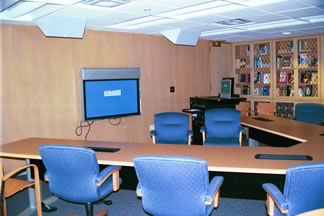
Courtesy of Joanne Henning
Advertising Available Services
For students initially walking into an information commons, the first impression is that a lot of technology is available, but it is not clear for what purpose. To advertise the range of activities possible in the commons, libraries can provide visual cues to inform students of the rich information resources, the range of software, and the services offered. Some information commons have used colorful banners to promote services. The computer default screens and mouse pads in the information commons can promote the content, software, and services students can access. Libraries can display digital resources on large screens to illustrate the rich content available for use in course projects. The information commons can exhibit student products developed as a result of work in the commons. Staff can collaborate with student focus groups to refine the language of signs that indicate services available. For example, merely adding the word "research" to a sign designating reference services seemed to greatly improve student understanding of what types of questions they might ask at that service point at one information commons.10
Students exploring college choices as well as students new to campus may initially explore the library through its Web site. In many cases, it is difficult, if not impossible, to find information about the library's information commons on the library's Web pages. The information commons Web pages could foster the close connection of its resources to learning by emphasizing how the content, hardware, software, and space that it provides are useful for course projects.
Linking to Courses
Librarians can seek out likely courses and work with the faculty to forge a closer relationship between the resources available in the information commons and course assignments. For example, in a course where students do oral history projects, the librarian could work with faculty to develop a guide to sources of context (newspapers, books, image collections, diaries) that would assist students in shaping their projects, and then offer a class or online tutorial to help them use equipment and software to record and edit oral histories that they capture themselves, providing the tools they need to develop a narrative presentation.
Information on the hardware, software, and services offered in the information commons that would be useful for course projects could be embedded into a course management system as well.
Often learning can be strengthened by integrated services. Physical colocation can lead staff to reconfigure services. For example, at Dartmouth College the library reference staff, information technology service staff, and writing center are located on one floor of the library. They have developed a program in which they jointly provide intensive training to a group of students who serve as peer tutors for locating information (library) resources, using technology, and improving writing for course assignments. Normally, these three functions are separate, but students' needs often cross administrative boundaries. The students advertise their services by making brief presentations in writing-intensive classes and scheduling appointments in a library tutoring center.11
Leveraging Technology
Providing new types of technology can help the information commons enhance learning. A new option called TeamSpot is currently available in libraries at Stanford University, which calls its implementation GroupSpace [http://academiccomputing.stanford.edu/groupspace/teamspot.html] (see chapter 35), and the University of Washington, among others. The setup allows a small group of students to connect their laptops to a large display screen that participants can individually control from their desktops (or using a digital pen or remote control), facilitating collaborative work.
Classrooms
Many information commons incorporate classrooms equipped with a variety of technologies, including computers and projectors, smartboards, video editing equipment, and videoconferencing capabilities. Often one or two classrooms are set aside for the library's information literacy instruction program. Classrooms available for general use are either assigned by the registrar or scheduled by the library. On many campuses, concerns have arisen that some faculty request the technology-enabled classrooms because of their location or newness rather than a need to incorporate technology into the learning process. Given the limited number of these classrooms, it would be to the institution's advantage to verify that the classes using these spaces genuinely use the technology. The information commons staff can also make a special effort to develop tools and services for the courses held in their facility. (See Figure 3.)
Figure 3. Flexible Furniture in Emory University Classrooms
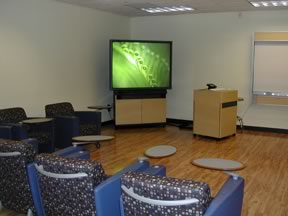
Courtesy of Joanne Henning
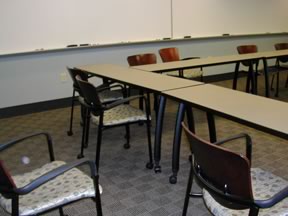
Courtesy of Joanne Henning
Information Commons Development
Given their inherent connection to technology, information commons will need to continually change as hardware, software, and networking configurations evolve. Also, as more faculty incorporate technology into the curriculum, and particularly as they encourage student use of technology in their academic work, the use of information commons will increase and change. This section identifies some significant issues and trends likely to influence the evolution of information commons.
Mission
Institutions should have a clear purpose for their information commons and yet understand that flexibility will be needed as it evolves. Some institutions try to communicate the mission by renaming a renovated facility, as in the case of libraries or computer labs that have evolved into learning commons. In the learning commons students can perform a wide range of technology and information-related activities in space conducive to group work.12 The types of facilities described in this chapter are variously called an information commons, learning commons, knowledge commons, or simply commons. In some cases, the traditional term library is used, with no special designation for the area in which these new configurations and services can be found. Some institutions refer to an area of the library as an information or learning commons despite no discernable differences from a traditional reference area. While the name of the facility can be important in conveying its functions to potential users, it is far more important to develop a clear mission for the space and to configure it to support learning.
Assessment
Librarian Joanne Henning visited 25 information commons during a study leave. She asked personnel at each site about the type of assessment conducted there. She found that "few libraries have done formal assessments of their ICs [information commons]; even fewer did a formal information gathering of potential users before implementing the IC" (http://jhenning.law.uvic.ca/final_report.html [archive link: https://web.archive.org/web/20150715002328/http://jhenning.law.uvic.ca:80/final_report.html]). Planners of information commons should talk with users to develop an understanding of their needs and priorities. Developing a vision and/or mission statement to guide planning decisions for the information commons will likely be an iterative process. This mission and associated goals should guide the development of a coordinated assessment program for the information commons. Such a program could combine statistical data (gate counts, use of equipment and software, information requests) and qualitative data (interviews with student and faculty users). Ideally, results can be compared with data gathered prior to construction of the information commons. This data can reveal needed changes (satisfaction with services, need for additional equipment or software), justify additional funding, and demonstrate the commons' contribution to teaching and learning.
Services and Staff
While the planning of an information commons frequently begins with the development of a floor plan and consideration of equipment and furniture, a better first step is to understand what types of activities users will engage in and what services will be needed to support those activities. This will have implications for the campus partners involved in the facility, the resources needed, the location of service areas, and the types of support staff. For example, the need to create multimedia products has implications for hardware, software, network infrastructure, furniture, and staff expertise. Or, if the information commons is to provide formal learning that incorporates technology, then classroom space will be required. Institutions that want to draw faculty into the facility sometimes move the campus teaching and learning center into the information commons.
Developing services that have a virtual and physical component is one of the opportunities and challenges of information commons. At the University of Tennessee, Donna Braquet, life sciences librarian, developed a Web site called "bioLIBlog: Explore, Share, Grow"
…as a place for biology students to network and communicate about biological information. This site serves as a one-stop location to ask questions and read responses, post comments about the Biology Night film series, and share science-related blogs, Web sites, books, journals, and magazines with your peers.
The in-person component is a biology-related film series and discussion, held in the library auditorium. The University of Minnesota library hosts a blog service called UThink: Blogs at the University Libraries [http://blog.lib.umn.edu/] for the campus; their Web pages offer advice to faculty on how to use blogs in teaching and provide guidelines to students and faculty for developing blogs. The library also hosts occasional in-person events related to blogging.
Information commons staff typically are located at service desks. Some information commons have a service desk jointly staffed by library and IT staff; others have separate desks for library services, IT services, and those other services housed in the information commons (such as a career center or writing center). Staff of the various units often offer the same types of services they offered prior to the information commons; they do not take advantage of the new configuration to rethink their services or staffing patterns. Two innovative facilities?Dartmouth and Georgia Tech?have altered staffing by hiring students and giving them intensive training by partner units. Dartmouth consolidated its library, IT services, and writing center in one facility. At Georgia Tech, the library and IT units provide intensive multimedia creation training to graduate students who then assist other students in a heavily used service. An increasing number of institutions probably will draw on the talents of their students to deliver services in the information commons. The types of services developed by Dartmouth and Georgia Tech accomplish a number of things:
- They leverage the colocation of various units by providing new services that take advantage of the combined talents and expertise of each professional group.
- They use peers whom students are more likely to approach with questions.
- Services can be offered during more hours of the day due to the willingness of students to work later hours than most staff.
One area for additional collaboration is for information technologists and librarians to work more closely with teaching and learning center staff housed in the information commons. The opportunity for enhancing the curriculum through the combined knowledge of these groups is great.
Furniture
Flexibility is the key consideration in choosing furniture for an information commons. As technology-oriented facilities, they need to change as student use patterns change. For example, the need for fixed workstations rather than tables where students can plug in their own laptops is shifting on many campuses. Soon students may adopt smaller devices such as notebook computers and cell phones, with implications for furniture configuration. Most information commons furniture has wheels for easy mobility. Generally, a mix of desk-style furniture and soft, comfortable seating is desirable. Some information commons include diner-style booths for small groups or areas with beanbag chairs for informal seating. Furniture that allows privacy for small groups while providing a means for people to see above barriers is desirable. Portable whiteboards, used in only a few information commons, might be more widely adopted for sharing information and defining group space in an open area. (See Figure 4.)
Figure 4. Diner-Style Seating at University of Nevada Las Vegas Library
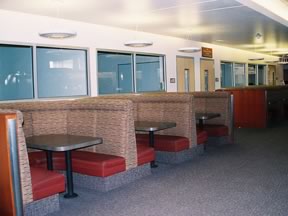
Courtesy of Joanne Henning
Technology
Users of the information commons will continue to want wireless network connections for convenience. Sometimes they will need wired Internet connections for specific applications or when wireless connectivity becomes saturated. In addition, power outlets should be ubiquitous so that students can plug in their multiple devices.
Hardware and software choices should be left until the last possible moment before opening an information commons in order to ensure purchase of the latest versions. Will hardware be standardized? Will the same software be loaded onto each machine, or will some have unique software, such as GIS? Many information commons have lending services for laptops, digital and video cameras, and other devices.
In the future, information commons may provide 3D visualization labs, where streams of data are combined to illustrate research concepts. Having a shared institutional resource in the library increases its value to the organization,13 as not every department can support this type of high-end facility or provide trained staff to operate it. Visualization is becoming increasingly important in many of the sciences as well as in business and the humanities.
Model for More than the Library
Historically, computer labs were designed to hold the most hardware possible in a limited space, loaded with a wide range of software. Configured for individual use, user desk space is limited. Frequently, the labs are staffed by student assistants who primarily provide security for the equipment and check student IDs. In contrast, information commons are configured, at least in part, for group use and have varying furniture configurations to support different modes of use. As campuses rethink the purpose and utility of their computer labs, they may look to the information commons as a replicable model for computer labs, as does the University of Tennessee.14 The reconfiguration would require new furniture and a new model of staffing, with more highly trained staff available to assist with student needs. The Computing Center at Cox Hall at Emory University (see chapter 8) provides an example of a new-style computer lab, with many group areas, comfortable and moveable furniture configurations, and small classrooms.
College or departmental libraries may transform all or part of their facilities into information commons, as has occurred at the Vanderbilt University Peabody Library, which serves the College of Education, and the University of Iowa Hardin Library for the Health Sciences. In the future, these facilities may integrate with the college or department computer lab. In large universities with multiple libraries, the undergraduate library (or part of it) may transform into an information commons, as happened at The University of Texas at Austin.15 Information commons may be part of new buildings that combine library and technology resources with a large number of technology-enabled classrooms, such as the University of Georgia Student Learning Center (see chapter 41).
Some information commons will develop specialized areas or features. At the Dartmouth College Library, a News Center offers comfortable seating, current print and electronic newspapers, Web access to many electronic news resources, and a large display screen featuring news from around the world. (See Figure 5.) Other organizations might develop group study rooms for graduate students, incorporating electronic thesis and dissertation (ETD) software, guidelines, and other resources. Indiana University Bloomington has created a quiet information commons on a floor above the bustling main information commons. Information commons will encompass new models and variations, with a wide variety of names, but all will support learning by integrating technology, content, and services in physical space.
Figure 5. Dartmouth Baker/Berry Library News Center
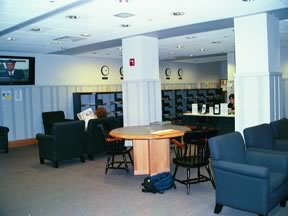
Courtesy of Joanne Henning
Transforming the entire library into the information commons model may be particularly suitable for institutions serving primarily undergraduates. In addition, individual components of the information commons model may be adopted in college or department classroom buildings, such as at Georgia Tech, where some departments have replicated the practice presentation room pioneered in the library's information commons.16
Aesthetics
While successful information commons have a palpable buzz as students collaborate and interact, the spaces themselves often have a rather austere, even dull, appearance. Information commons generally do not sparkle. Often decorated with neutral colors and utilitarian furniture, they are dominated by computers. The one colorful place may be the café. In the future, planners may pay more attention to aesthetics. Some institutions are involving students in their design process and are seeking ideas from business and retail as they plan new spaces.17 The use of lively colors, interesting patterns and textures, and natural light can enhance the aesthetic appeal of the information commons. If at all possible, the budget for renovating space for an information commons should include funds for architects and designers.
One facility that has great aesthetic appeal is Emory University's Computing Center at Cox Hall, a computer facility and not, strictly speaking, an information commons. The facility uses a mix of attractive colors, small but brightly colored lamps, and fanciful furniture to convey a welcoming, informal atmosphere. Several areas provide coffee-table-height surfaces that hold a computer, surrounded by floor cushion seating. The eye-catching combination appeals to many students. This generally informal facility also houses two small classrooms and a more formal conference room, with rich wood surfaces.
The information commons can also build community on campus. Cafés, art display areas, and spaces for films or concerts can all foster campus community. The library can develop Web links and virtual displays to connect in-person events to resources available in the library and on the Web. This type of programming can provide informal learning opportunities for students and others on campus.
Conclusion
With careful planning (see the sidebars), an information commons can be a collaborative learning space, not just a glorified computing lab; it can be a place to access, use, and create information, not just a reference area with rows of computers; and it can provide transparent user services, not fiefdoms of service points. Information commons can enhance learning, provide an environment for students that is both academic and social, and foster a sense of community on campus. Information commons require a large commitment of campus resources to develop and maintain. Clearly articulating the information commons' link to learning and then developing the requisite services and environment can help justify that investment and create a popular and mission-critical space on campus.
Endnotes
- Among others, exceptions include the James and Anne Duderstadt Center at the University of Michigan (http://www.dc.umich.edu/) and the Johnson Center at George Mason University (http://ulcweb.gmu.edu/concept/mission_statement.htm [archive link: https://web.archive.org/web/20030420231908/http://ulcweb.gmu.edu/concept/mission_statement.htm]).
- Suzanne Thorin, "Models of Successful Information Commons," presentation at Academic Libraries 2005: The Information Commons, Saratoga Springs, New York, November 10–11, 2005.
- Dan Gjelten, posting on the EDUCAUSE LIBIT listserv, October 31, 2005.
- I use the terms "information commons" and "learning commons" interchangeably in this chapter. Although in principle they could describe facilities with different missions, in practice I have found no direct correlation between what the facility offers and its name. Another variation is to name the area simply the Commons. Some sources that provide good background on information commons include D. Russell Bailey, "Information Commons Services for Learners and Researchers: Evolution in Patron Needs, Digital Resources and Scholarly Publishing," INFORUM 2005: 11th Conference on Professional Information Resources (in Czech), Prague, May 24–26, 2005, <https://www.inforum.cz/archiv/inforum2005/english/prispevek.php-prispevek=32.htm>; Donald Beagle, "Conceptualizing an Information Commons," Journal of Academic Librarianship, vol. 25, no. 2 (1999), pp. 82–89; and Leslie Haas and Jan Robertson, The Information Commons, SPEC Kit 281 (Washington, D.C.: Association of Research Libraries, July 2004).
- Caroline Crouse and Kristianne Buechler, "Starting with Assessment: The Development of an Information Commons from User's Needs," poster presented at the ACRL National Conference, Minneapolis, April 9, 2005.
- Alma Clayton-Pedersen with Nancy O'Neill, "Curricula Designed to Meet 21st-Century Expectations," in Educating the Net Generation, Diana G. Oblinger and James L. Oblinger, eds. (Boulder, Colo.: EDUCAUSE, 2005), <http://educause.edu/research-and-publications/books/educating-net-generation>.
- Quoted by Barbara Dewey and Brice Bible, "Relationships and Campus Politics in Building the Information Commons," presentation at Academic Libraries 2005: The Information Commons, Saratoga Springs, New York, November 10–11, 2005.
- Colleen Carmean and Jeremy Haefner, "Mind Over Matter," EDUCAUSE Review, vol. 37, no. 6 (November/December 2002), pp. 26–34, <http://www.educause.edu/ir/library/pdf/erm0261.pdf>.
- George D. Kuh and Robert M. Gonyea, "The Role of the Academic Library in Promoting Engagement in Student Learning," College & Research Libraries, vol. 64, no. 4 (July 2003), <https://crl.acrl.org/index.php/crl/article/view/15605/17051>.
- This was a finding at the University of Massachusetts Amherst Learning Commons.
- Dartmouth College, RWIT: The Student Center for Research, Writing, and Information Technology, <http://writing-speech.dartmouth.edu/learning/rwit>; Dartmouth does not use the term "information commons" to describe its facility.
- Malcolm Brown, "Learning Spaces," in Educating the Net Generation, Diana G. Oblinger and James L. Oblinger, eds. (Boulder, Colo.: EDUCAUSE, 2005), <http://educause.edu/research-and-publications/books/educating-net-generation>.
- Bernard Frischer, "The Ultimate Internet Café: Reflections of a Practicing Digital Humanist About Designing a Future for the Research Library in the Digital Age," Library as Place: Rethinking Roles, Rethinking Space (Washington, D.C.: Council on Library and Information Resources, 2005).
- Dewey and Bible, op. cit.
- Katherine S. Mangan, "Packing Up the Books," Chronicle of Higher Education, July 1, 2005, [http://chronicle.com/free/v51/i43/43a02701.htm].
- Linda Cabot and Crit Stewart, "The Evolution of Collaborative Learning Spaces: What We've Learned," presented as part of a general session at the 2005 EDUCAUSE Southeast Regional Conference. The PowerPoint slides from their presentation are available on the Web at [http://www.educause.edu/upload/presentations/SERC05/GS02/EDUCAUSE%20SE%202005%20cabot%20stuart2.ppt].
- Chad Kainz, "Thinking Space," presentation at the ACRL Preconference, American Library Association, 2005, <http://hwaet.typepad.com/thinking_space/ [archive link: https://web.archive.org/web/20060505050228/http://hwaet.typepad.com/thinking_space/]>.
About the Author
Joan K. Lippincott is the associate executive director of the Coalition for Networked Information (CNI), a joint project of the Association of Research Libraries (ARL) and EDUCAUSE. She held positions at Cornell University, Georgetown University, George Washington University, and SUNY Brockport and has worked in the Research and Policy Analysis Division of the American Council on Education (ACE) and at the National Center for Postsecondary Governance and Finance (NCPGF). Lippincott has written articles and made presentations on Net Gen students, learning spaces, collaboration among professional groups, assessment, and digital information. She received her PhD in higher education policy, planning, and administration from the University of Maryland.